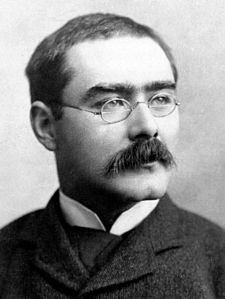Great Personalities » Rudyard Kipling

Rudyard Kipling
Rudyard Kipling, one of the greatest English poets was born somewhere in Bombay, India, on 30 December 1865. John Lockwood Kipling, his father, was an arts teacher at the Jeejeebhoy School of Art. Alice, his mother, was the sister-in-law of the famous painter Edward Burne-Jones. During this period, India was being rule by the British.
An Indian Ayah [nanny], who taught him the basics of Hindi, brought up Kipling. In fact, it was his first language, until he was sent to England to stay with a foster family in 1870, at the age of six. There, he was sent to a boarding school in Devon. In 1890, Kipling, detailed this period of his life in the book, “The Light That Failed in 1890.’ This period was also mentioned in his autobiography in 1937.
Kipling joined the United Services College, a boarding school in North Devon in 1878. The college was an expensive institution that mainly specialized in training students for military academies. Kipling’s hopes of a military career were dashed given his poor eyesight and his mediocre academic results. However, Kipling's partiality to reading and books separated him from the rest of the students.
In 1882, Kipling returned to India where he worked as a journalist in Lahore for a Military and Civil Gazette for five years. He then moved to Allahabad and worked for the Allahabad Pioneer as an overseas correspondent and Assistant Editor for over two years. The last two years of his period in India are best illustrated in the book, The Phantom Rickshaw. In it was the legendary story 'The Man Who Would Be King.' This was later made into an extremely thrilling Hollywood movie.
Kipling gained popularity in England through his short stories during the 1880s. In fact, in 1889, he was hailed as a literary heir to the famous Charles Dickens. He toured Japan, sometime in the late 1880s and advised them not to eagerly adopt western values and fashions. Between the years 1889 and 1892, Kipling published a collection of Indian stories that included 'The Man Who Was,' and a collection of poems called Barrack-Room Ballads. It was in that he praised a Hindu water carrier for a British Indian regiment called Gungadin. However, Wellington had viewed Gungadin as "the very scum of the earth,” although Kipling portrayed him as an embodiment of British virtue.
Sometime during 1892, Kipling married the sister of an American publisher and writer, named Caroline Starr Balestier. In fact, their relationship grew while she was helping him in the publishing of a novel. After marriage, he moved to the United States with her. However, his happiness was short-lived as his daughter, Josephine passed away at a young age. He then returned to England and settled in Burwash, Sussex.
After his daughter’s death, Kipling not only became a tougher man, but his political beliefs also began to harden. As a result, his marriage also suffered, as his wife began to find it difficult to accept her husband’s new character. It was during these restless years, Kipling wrote Many Inventions in 1893, and the wonderful compilation of animal stories for children, aptly titled, The Jungle Book in 1894. The Second Jungle Book in 1895, The Seven Seas in 1896, and Just So Stories followed this in 1902, which were all illustrated by Kipling.
Kipling was considered as an unendorsed poet laureate and was also given the order of Merit. However, Kipling refused these as well as many other honors. Kipling He later moved to Sussex in 1902, while also spending time in his home in South Africa, which was presented to him by Cecil Rhodes, the influential British colonial diplomat.
It was in 1901, that Kipling released KIM, which took him eight years to compile, and is widely considered his best novel. The story was set in British India and it portrays the adventures of Kimball O'Hara, the orphan son of an Irish color-sergeant in an Irish regiment. Kim meets a Tibetan Lama and becomes a disciple of the old man. Kim works for the British Secret Service, and was carrying a vital message to the Colonel Creighton, situated in Umballa. The Lama helps him on his journey. During the chain of events, Kim is separated and then rejoins the Lama in an expedition to the hill country, and his destiny is left undecided. Kim is thrilled by the dangers of adventure and the various consequences that follow excite him.
His own children featured in these stories as Dan and Una. However, the death of "Dan" (John) during the World War 1 further hardened and isolated him. John Kipling was a brave young office, who died at the young age of 18 in the Battle of Loos.
His writings soon began to decline after he had received the Nobel Prize. In 1923, Kipling published a history about his son’s regiment, The Irish Guards. He was also a rector during the years 1922 and 1925, at the St. Andrews University.
Kipling died on 18 January 1936 in London. Readers liked Kipling’s sympathy for the world of children and his romantic tales about adventure. They also liked his tales about the adventures of Englishmen in strange and distant parts of the world.
Was this article useful? What should we do to improve your experience? Share your valued feedback and suggestions!
Help us to serve you better. Donate Now!
